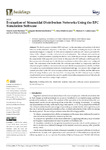Evaluation of sinusoidal distribution networks using the EPC simulation software

Use this link to cite
http://hdl.handle.net/2183/32937
Except where otherwise noted, this item's license is described as Attribution 4.0 International (CC BY 4.0) https://creativecommons.org/licenses/by/4.0/
Collections
- Investigación (EPEF) [593]
Metadata
Show full item recordTitle
Evaluation of sinusoidal distribution networks using the EPC simulation softwareAuthor(s)
Date
2023-03-08Citation
León-Martínez, V.; Montañana-Romeu, J.; Peñalvo-López, E.; Graña-López, M.A.; Valencia-Salazar, I. Evaluation of Sinusoidal Distribution Networks Using the EPC Simulation Software. Buildings 2023, 13, 716. https://doi.org/10.3390/buildings13030716
Abstract
[Abstrac] Abstract
The electric power calculator (EPC) software, for the simulation and analysis of electrical networks at the industrial frequency, is described in this article, including its source code and operational diagram. Compared to well-known commercial software, EPC directly provides the values of the voltages, currents, and powers in each subsystem. The voltages and currents are calculated, in phasor notation, applying Kirchhoff’s laws, while the powers are obtained through the components of the apparent power vector. In this paper, the EPC software could be applied to three-phase networks made up of a distribution transformer and two three-phase wye-configured loads. The correctness of the results of the EPC software was verified by comparison with those obtained using the Multisim commercial software and with the measurements recorded by the Fluke 435 analyzer in a real distribution network of residential buildings. The values of the voltages and currents provided by the EPC were the same as those measured by the Fluke, and the differences observed using Multisim were less than 0.6%. Consequently, the EPC software is an excellent complement for power analyzers, because it is capable of providing measurements in all the network subsystems at the same time, using a single analyzer.
Keywords
Building networks
Distribution systems
Simulation software
Power measurement
Industrial frequency
Distribution systems
Simulation software
Power measurement
Industrial frequency
Editor version
Rights
Attribution 4.0 International (CC BY 4.0) https://creativecommons.org/licenses/by/4.0/
ISSN
2075-5309






